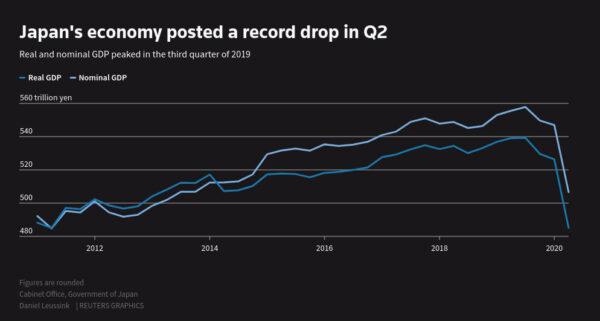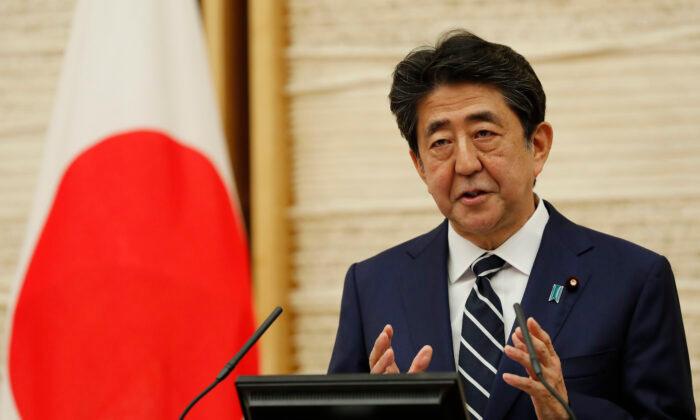Japanese Prime Minister Shinzo Abe’s signature shock-and-awe “Abenomics” stimulus strategy was already faltering even before his decision on Friday to step down due to health reasons.
That blunt assessment by many Japan observers underlined the daunting political challenge Abe has faced in his efforts to pull the economy out of decades of economic stagnation.
And the coronavirus crisis may have just put the final nail in the coffin to his ‘three arrows’ reform programme as the economy sinks deeper into recession, analysts say.
After sweeping to power in late 2012, Abe deployed his three arrows of Abenomics—large-scale monetary easing, fiscal spending, and structural reforms—to reignite the world’s third biggest economy after years of subpar growth and falling prices.
There were some quick-hit successes.
The Bank of Japan’s “bazooka” stimulus programme lifted business sentiment and helped weaken the yen, giving exporters windfall profits that trickled down to wages and new jobs.
Corporate governance reforms drew in huge amounts of overseas money, pushing up foreign ownership of Japan’s listed stocks to a record 31.7 percent in 2014 from 28 percent in 2012. It stood at 29.6 percent in 2019.
“We were able to end 20 years of deflation with the three arrows of Abenomics,” the prime minister told a news conference on Friday announcing his resignation, when asked what he thought were his legacies.
But Abe will leave behind a pile of unfinished business for his successor.
“The focus at the moment will be on the coronavirus recovery and controlling the infection, regardless of who will be the next prime minister,” said Takeshi Minami, chief economist at Norinchukin Research Institute.
“There has been talk that Abenomics has been having a harmful impact, so I think the focal point will be on suggestions how to make changes to it.”
The biggest disappointment for the prime minister, and many Japan observers, is that the third-arrow reforms to reshape an economy hobbled by low productivity, a rapidly ageing population and a rigid labour market, have proved elusive.
Paying the Price
Now, Japan is paying the price as COVID-19 wipes out the short-term benefits brought by Abenomics, such as an inbound tourism boom, reflated growth and rising job availability.Abe’s failure to entice companies to spend more on capital expenditure has given Japan Inc a huge cash-pile that served as a liquidity buffer to weather the pandemic’s shock.
But the experience may give firms an excuse to keep hoarding cash rather than spend on new business opportunities, which could stifle innovation and weigh on Japan’s potential growth—factors Abe was focussed on addressing through the third arrow.
“COVID-19 may have reassured corporate executives that cash is indeed king,” said Hideo Hayakawa, a senior fellow at the Tokyo Foundation for Policy Research. “My fear is that companies may feel even more inclined to save rather than spend.”
Social distancing policies and other business constrains to contain the virus may cripple potential growth—already low due to slow progress in deregulating highly-protected medical and agriculture industries, and accepting more foreign workers to address chronic labour shortages.
Japan’s potential growth rate, which used to exceed 4 percent in the 1980s, slid near zero last year from around 1 percent before Abenomics began, according to BOJ estimates.
“Structural reform, or the third arrow, has been the declaring failure of Abenomics,” said Samuel Tombs, chief U.K. economist at Pantheon Macroeconomics.
Deflationary Mindset
COVID-19 also dashed a grand experiment of Abenomics that aimed to turn around Japan’s “deflationary mindset,” in which companies and households hold off on spending on expectations that low growth and wages will persist.The economy stumbled to a record contraction in the second quarter that shrank nominal gross domestic product (GDP) to 507 trillion yen ($4.8 trillion), around levels marked in 2013 and far distant from Abe’s 600-trillion-yen target.

“Japan’s economy may have performed better after Abenomics, but not enough to change public sentiment dramatically,” said Yoshiki Shinke, chief economist at Dai-ichi Life Research Institute.
“With the pandemic, we’ll likely see growth fall further. With many legacies of Abenomics wiped out, we know now there was no magic wand to fix Japan’s chronic woes,” he said.
Moreover, with the BOJ having exhausted its tool-kit to achieve its elusive 2 percent inflation target, policymakers face the challenge of seeking to revive the economy with a dearth of ammunition.
Japan’s huge debt also limits room for big fiscal spending, which may keep any economic recovery weak, analysts say.
“Japan failed to normalise monetary and fiscal policies when the economy was in better shape,” said former BOJ board member Takahide Kiuchi. “Now, it’s paying the price.”






Friends Read Free